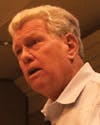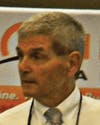One of the perks of attending a professional development conference is coming home with a tote bag full of free goodies. While it's great to add to your collection of flashlights, fancy pens and beer cozies, it's even better to come back with ideas, insights and inspiration that reenergize you to tackle the challenges of the workplace.
Judging by the feedback from attendees of EHS Today's 2014 Safety Leadership Conference in Indianapolis, EHS leaders returned home with more than just a few trinkets.
EHS managers and thought leaders discussed and examined some of the most important issues facing the profession today. Those issues included employee engagement; transformational leadership; substance abuse in the workplace; temporary-employee safety; workplace violence; contractor safety; OSHA inspections; and safety culture.
With that in mind, we'd like to highlight a few of the many pearls of wisdom from the event.
"Becoming more transformational will not just make you a better professional, it will make you a better person."
– Dr. Rick Fulwiler, president, Technology Leadership Associates
"If you're continuing to push safety compliance, and you don't get into the continuous improvement of safety where people see you as a valuable resource, it's not a very nice place to be, because you're seen as the safety police."
– Robert Hafey, president, RBH Consulting LLC
"Does it ever feel like you're in a boxing match? Does it seem like a tug-of-war for time, money and resources?"
– Mark Lewandowski, machine controls technology leader,
Rockwell Automation
"Very few great leaders are born great leaders. They make
themselves great leaders."
– Jim Spigener, senior vice president, BST Solutions
"Enjoy what you do. Enjoy safety."
– Eric Evans, safety coordinator, Honda of South Carolina Mfg. Inc.
"If you're not doing site-specific training [for temporary employees], you're going to get cited, I'm confident of that."
– Ed Foulke, former OSHA administrator and partner at
Fisher & Phillips LLP
"I have a lot of concerns about less-frequently cited industries, like retail, healthcare and hospitality, as well as the normal focus on manufacturing. A lot of businesses still view the concept of building a safety culture and driving it through the use of leading indicators as sort of a soft subject. They don't see how it cuts workers' comp costs or, more importantly, how it benefits the enterprise and makes more money for them."
– Howard Mavity, partner Fisher & Phillips LLC
"If an employee sees [a hazardous condition], the previous method was they would submit a maintenance ticket or push it off on somebody else. The nice thing about find-and-fix is it encourages employees to take ownership, think about the solution and play a part in implementing it. That ownership can drive a lot of engagement."
– Jon Hansen, global health and safety manager Kennametal Inc.
Beyond OSHA
"When we were deciding what to do next, we couldn't look at [lost-time] injuries and say we had to do something. There weren't any. Instead, I told my senior management that the standards were changing, that we didn't understand what our risk or liability really was."
– Bryan Harrell, automation engineer consultant Eli Lilly
"We really wanted to get to the point where our maintenance teams not only would understand what they were supposed to do but also would accept and embrace the rules and see the relationship between safety procedures and going home at the end of the day. We wanted them to follow the rules not because they're rules, but because we care about them and we firmly believe that if they follow the safety rules, they're not going to get hurt in our plants."
– Rick Gerlach, senior director of safety and health Cintas Corp.
"It is estimated that prescription drug abuse costs employers $81 billion annually. Nearly three-quarters of the people using illegal drugs are employed."
– Danielle Urban, partner Fisher & Phillips LLC
"We can't correct something if our employees don't feel comfortable coming forward with improvement ideas."
– Kathie Bunge, manager, global OEMS, Dow Corning
"When somebody points safety out to you, it's your job to make them feel so good that they're looking for the next person to help."
– John Drebinger, author and motivational speaker













